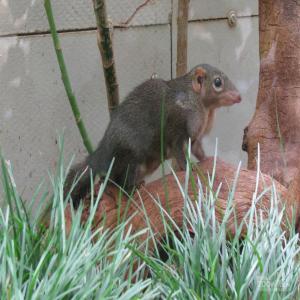 Northern Tree Shrews look remarkably similar to squirrels. They are the only members of their taxonomic order, and are native to Southeast Asia. They have grayish, olive fur, are diurnal and territorial, marking their spots using a scent located in the abdomen and chin. Their snout tends to be elongated. They are moderately sexually dimorphic, with males being slightly larger and having a broader skull than females. Males also have a white ring of hair around the eye, females, do not. The fur color and body shape tends to differ between males and females. They weigh between 50 to 270 grams, head to body length is 12 to 21 cm and a tail length ranges from 14 to 20 cm, which is usually close to the length of their body. Their body temperature ranges from 35 to 40 degrees Celsius which is a much greater difference than most endothermic animals.
Northern Tree Shrews look remarkably similar to squirrels. They are the only members of their taxonomic order, and are native to Southeast Asia. They have grayish, olive fur, are diurnal and territorial, marking their spots using a scent located in the abdomen and chin. Their snout tends to be elongated. They are moderately sexually dimorphic, with males being slightly larger and having a broader skull than females. Males also have a white ring of hair around the eye, females, do not. The fur color and body shape tends to differ between males and females. They weigh between 50 to 270 grams, head to body length is 12 to 21 cm and a tail length ranges from 14 to 20 cm, which is usually close to the length of their body. Their body temperature ranges from 35 to 40 degrees Celsius which is a much greater difference than most endothermic animals.
Location: Primate & Cat
Share:
Range
Northern Tree Shrews are found in Southeast Asia. They are native to Bangladesh, Bhutan, Cambodia, China, Lao People’s Democratic Republic, Malaysia, Myanmar, Thailand and Vietnam.
Habitat
They inhabit a variety of forest habitats in tropical and subtropical areas, which are normally moist environments. They have also been recorded in shrub lands and artificial plantations and rural gardens. The highest elevation in which they have been reported was about 300 meters in China. They inhabit areas with temperatures around 25 degrees Celsius and 45 to 50% humidity.
Conservation Status
Primary Threats
Gestation
Their Gestation period is 41 to 45 Days and females give birth to hairless, young.
Litter
Litter size 1 to 5.
Behavior
One adult male and female share overlapping territories, and both will defend their territories against other Shrews year round. Territorial fights are documented between adults of the same sex. Tree Shrews use scent marking, excreted from a gland on their chest, to mark their territories. The young tree shrews leave the nest around the onset of puberty and they become completely self-sufficient.
Reproduction
All Tree Shrews are territorial and introductions between a mating pair are possibly the hardest part of breeding for Northern Tree Shrews. Typically, Tree Shrews are monogamous and in order to mate, one animal must enter the others’ territory. Both male and female will use more aggressive behaviors during breeding. Their reproductive life begins at 4 to 5 months of age and they are able to reproduce at any time of year.
Wild Diet
Primary diet is eggs, insects, and fruit. They do not absorb much water from fruit and cannot go without water for more than about a day.
Zoo Diet

